Working (the land) 9 to 5
Join us on a journey from rural England to rural Dollywood
First: a caveat. Dolly Parton has never been to The MERL. At least, we don’t think so. But that’s not to say that our collection and the history of rural England aren’t filled with objects that have a remarkable Dolly twist.
In fact, this article was prompted by the fact that 2021 represents a big year for Dolly. Because twenty-five years ago, in 1996, Dolly the sheep (named after Dolly Parton) was born. Dolly was the first ever mammal to be cloned from an adult somatic cell, using cells taken from a mammary gland. And if you know anything about Dolly Parton, you won’t need us to explain the reference. Either way, this isn’t quite as woolly a connection as it might at first have seemed!
In this rural, musical tribute to Dolly and Dolly alike, join us as we combine Dolly Parton’s extensive catalogue of songs with our amazing catalogue of objects, archives and photographs, for a journey through countryside history that will take us all the way to rural Dollywood.
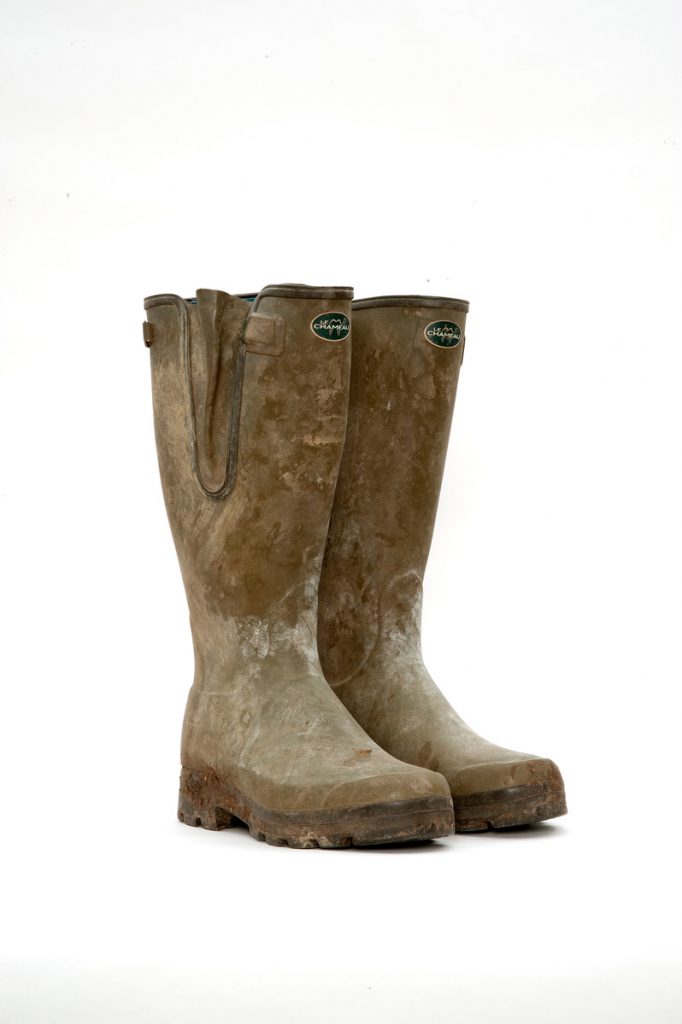
I Will Always Love You
Dolly’s I Will Always Love You is perhaps one of the greatest love songs of our generation. Please feel free to quote us on that. Although Dolly originally wrote this song for a good friend, it was cemented as the ultimate power ballad and love song by Whitney Houston in 1992.
Throughout history, people have found ways to express their love for one another in ways that are deeply personal and unique, and often extremely surprising. Whilst you might not immediately think of The MERL as a store of such tokens, you would be mistaken and are about to be pleasantly surprised!
Because in rural England in the 19th century, people would give each tokens of love in the form of personalised rolling pins. Just like this one.
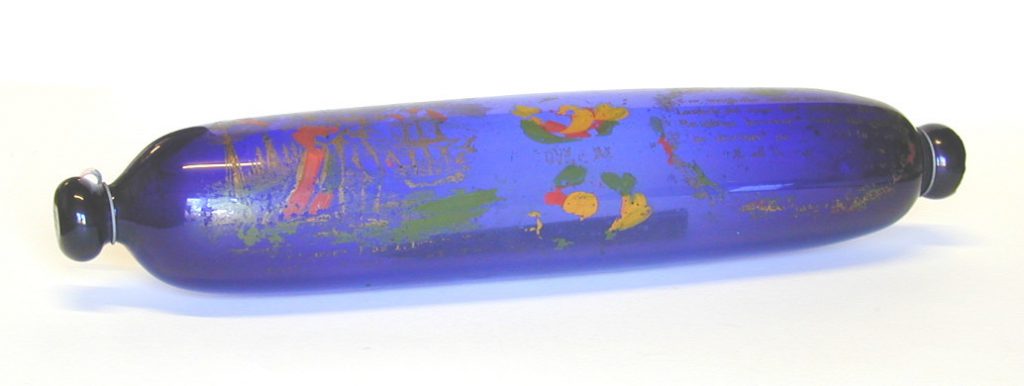
These rolling pins were a particularly popular token amongst sailors who would give them to their girlfriends as an indication of marriage upon their return from sea.
This rolling pin is made of beautiful blue glass, with gold, red and green images, painstakingly painted onto the glass showing a sailor telling his sweetheart he must leave for sea. The inscription, partly worn off, reads ‘…loves I as I loves…, PAIR as happy as WE, T.W., LOVE BE TRUE, Now weigh the anchor hoist the sail, launch out upon the pathless deep, resolved however veers the gale, The destined port…to…’
Another potential use for these rolling pins has also been suggested, that they were used to smuggle liquor, although that is far less romantic.
9 to 5

Although 2020/2021 has changed our working patterns quite drastically, many of us remain working 9 to 5 even if we are still in our pyjamas.
To make sure you clocked off both on time and in style, the pocket watch represented a fashionable staple for the 19th century gentleman. But if you ever wondered what they did with their watch at the end of the day, we have your answer.
Pocket watch holders like this one would sit on a nightstand and turn a simple watch into a fancy clock overnight. The next morning, somewhere in between jumping in the shower and stumbling to the kitchen, you would simply grab your pocket watch and get going.
This pocket watch holder features two dancing female figures in Highland dress, and many other examples feature groups of people dancing and posing around a little pocket watch.
This example was made in Staffordshire, most likely originating from the Staffordshire Potteries industrial area that now make up the city of Stoke-on-Trent. This area became the centre of ceramic production from the early 17th century thanks to the abundant supply of clay, salt, lead, and coal. The factories also developed new varieties of bone china, jasperware, and transfer printing and their work was exported around the world as prime examples of fine pottery. The area went through a period of decline in the late 19th century, as other countries developed their own techniques and the desire for this kind of home décor disappeared.
Islands in the Stream
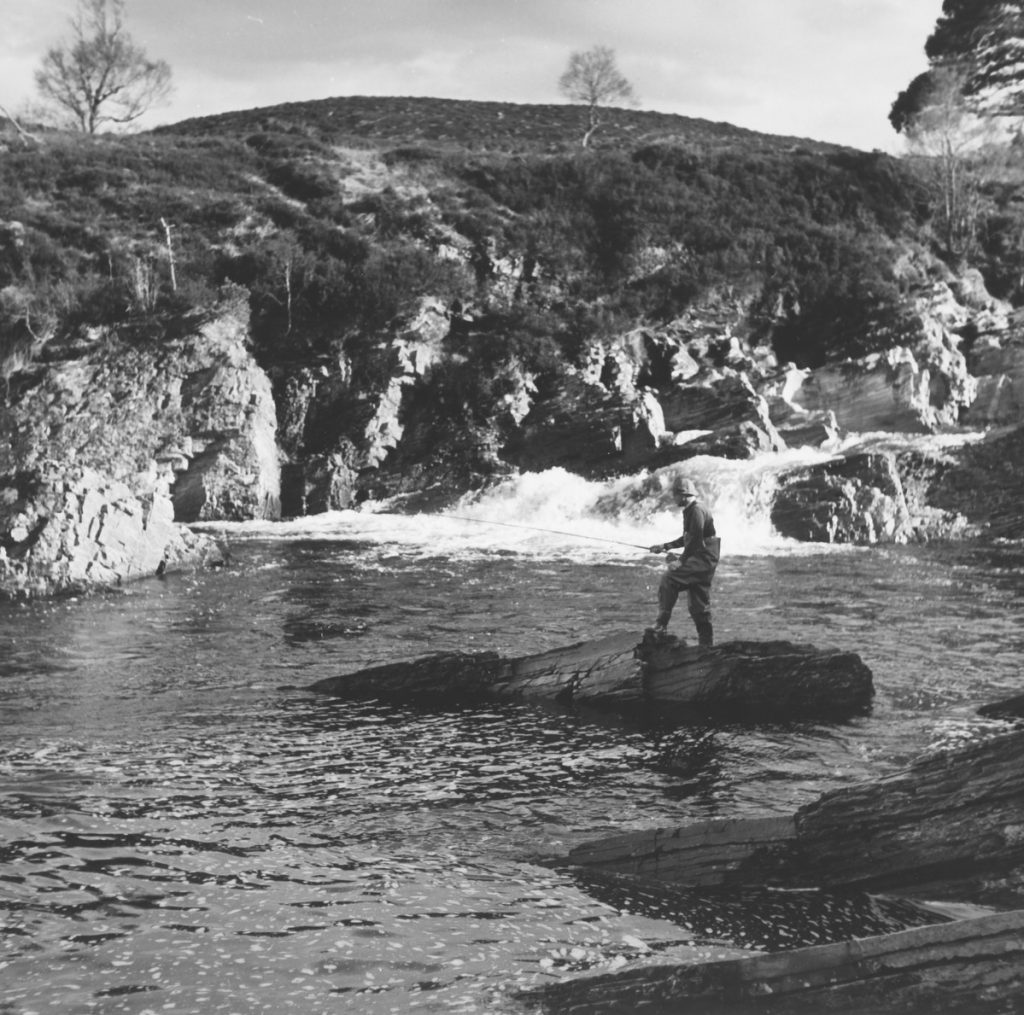
This image shows a man, standing on an island, …in a stream.
The man is fly fishing for salmon in a Highland stream in Sutherland, an area very popular for salmon fishing, and probably a tributary of the River Oykel or Einig. This amazing photo was captured by John Tarlton, who after serving as a photographer for the RAF in the Second World War, used his passion to capture images of rural Britain. His work was featured in publications like Farmer’s Weekly, The Field, and Country Life, and he regularly appears on our social media posts. For 51 Voices, our 70th anniversary project, we explored another of John Tarlton’s famous images of Fred Mizen and his straw creations.
Fly fishing uses artificial flies or bait to catch fish in open waters like rivers, and lakes. Fly fishing has a number of origins, some from Japan where it is known as ‘tenkara’ which means ‘from Heaven’. It had been recorded in Ancient Rome and Macedonia before it reached the shores of England. It wasn’t until after the English Civil War that fishing became a recognised sport and pastime in English society, although there is some reference to fly fishing by Shakespeare’s fishing buddy and fellow poet John Dennys in his book ‘The Secrets of Angling’, published in 1613 (i). Renowned Parliamentary Officer Roger Venables published ‘The Experienced Angler’ in 1662 which was a true exposé on how to catch the biggest and best fish in the fastest way possible. This enthusiasm was shared by another Civil War veteran, Richard Frank, who was the first to explore salmon fishing in the Scottish Highlands using an artificial fly (ii).
Salmon has been a popular fish throughout British history as a staple part of diets for most Europeans, thanks to the vast areas that Atlantic Salmon make its habitat. There have been regulations to protect salmon since 1030 AD and records of the decline of salmon population have been kept since 1215 AD.
It was noted that nets spanning across the River Thames in particular were responsible for this decline, as salmon were unable to return upstream to their natural spawning grounds (iii). Indeed, there was even a law created in 1986 which makes it illegal to handle salmon ‘in suspicious circumstances’.(iv)
Jolene
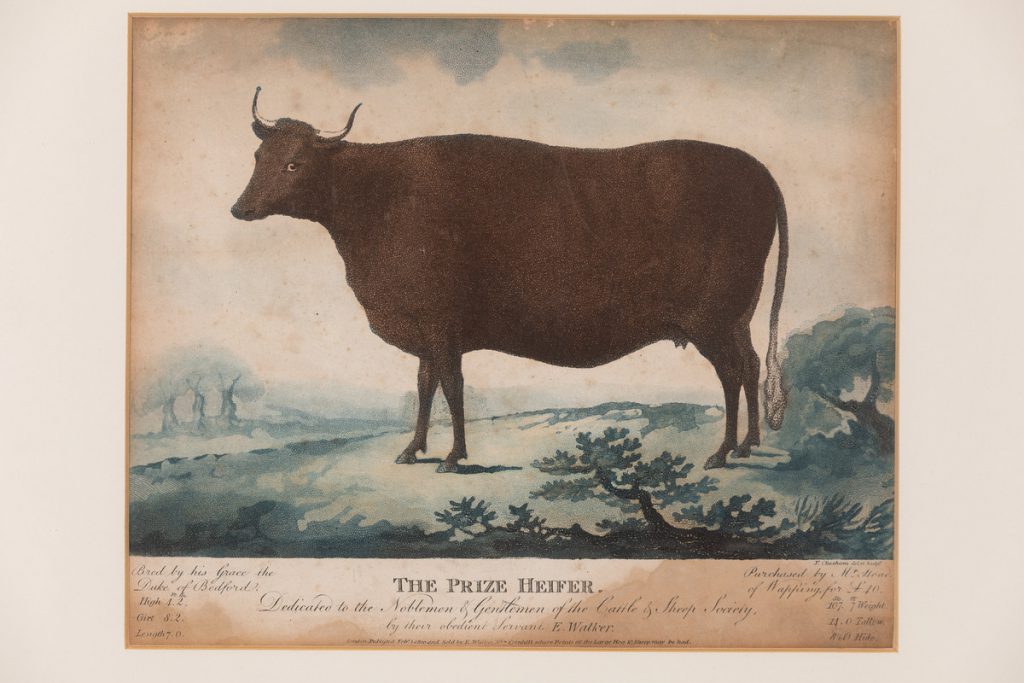
Her beauty is beyond compare, with her flaming locks of auburn hair (and ivory skin, and eyes of emerald green, probably), and this print from renowned engraver Francis Chesham captures the essence of Jolene to perfection. And if you were the wife of a cow breeder, she may well take your man.
Paintings like these were common in the 19th Century as they allowed traders to highlight their skill in breeding the finest examples of cows and sheep ever seen. They were the means of showing and advertising the qualities of animals and were painted on the instruction of the gentlemen farmer. Considerable license was practiced by and expected from the painter. Only an artist of the moral fibre of Thomas Bedwick actively protested at being expected to put ‘lumps of fat here and there where I could not see it.’ Thomas Weaver was a prime exponent of this artistic expression (v).
This ‘Prize Heifer’ (who will know forever be known as Jolene) was bred by the Duke of Bedford, and sold for a whopping £40 to a Mr. Head of Wapping. The print also details some of Jolene’s measurements including her weight of 107 stone and 7 pounds which would explain the hefty price tag.
Coat of Many Colours

This striking blue coat with a multicoloured detail was worn by Pam Ferris as the character Ma Larkin in the popular 1990s television show ‘The Darling Buds of May’ on the 1991 episode ‘Christmas is Coming’. The blazer also pictured was worn by David Jason as his character Pop.
Running to 18 episodes and two specials, the 1991-3 Yorkshire TV series ‘Darling Buds of May’ was immensely popular with the first season of programmes breaking viewing records when all six episodes reached number 1 in the ratings. Shot on location in the Kent village of Pluckley, it presents a Chaucerian vision of a lush and bountiful countryside of the 1950s presided over by Pop, a smallholder and chancer, with an enormous family and a heart of gold. The series was based on the 1958 novel of the same name, and its four successors, by H.E. Bates (1905-1974)
Whilst Dolly’s song about her Coat of Many Colours describes the harshness of rural living, the Darling Buds of May focuses on a fairly financially comfortable family. Their only income is through selling scrap, picking strawberries, and selling farm animals. Nevertheless, they happily spend money on horses, cars, fine furniture, and holidays abroad.
Here You Come Again
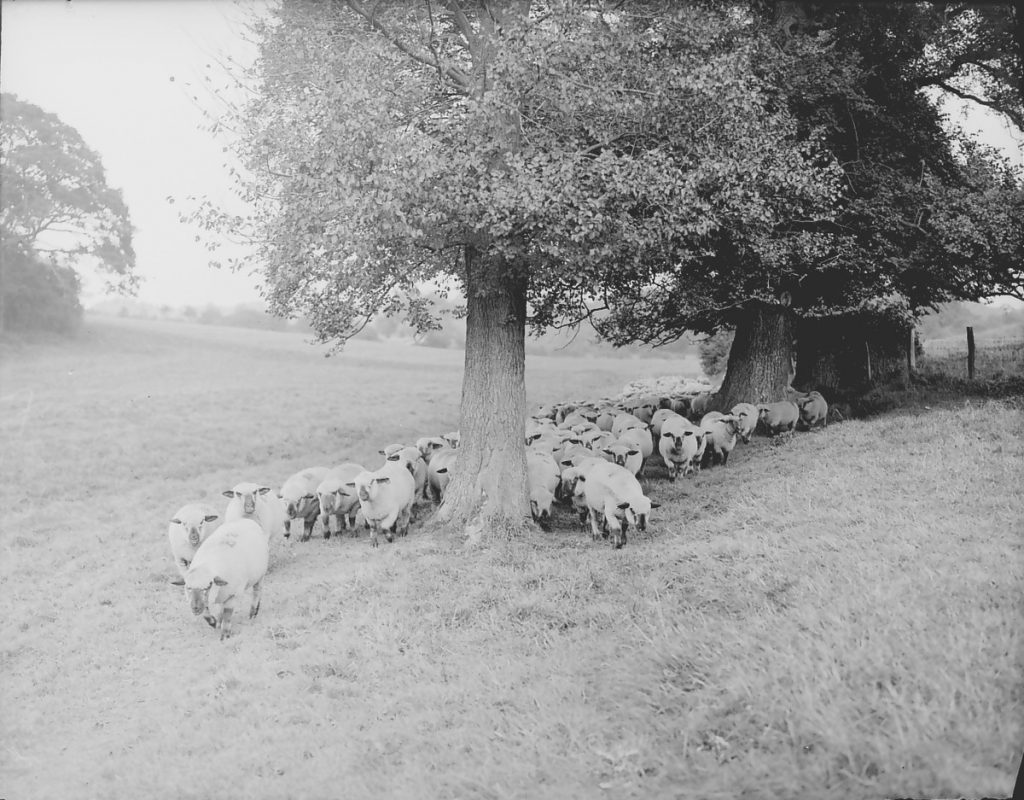
Shepherding is one of the oldest occupations in human history and was a vital part of society across the globe. Whilst it was a nomadic and isolated lifestyle, shepherds were important for protecting grazing sheep from predators. Flocks of sheep need large areas of grassland to graze, and it would be the shepherd’s job to move them from one area to another to maintain their food supply.
In more recent times, especially in England, the need for a shepherd to live and guard sheep on this scale has become unnecessary, due to the abolition of common land and a significant reduction of wild predators. Sheep farmers can leave their flocks to graze alone and moving them on to a new field when needed. Sometimes sheep do get lost, like Prickles in Tasmania, but overall, they are quite good at making their way back home.
This image titled ‘sheep returning home’ was taken by photographer Eric Guy who took pictures of English rural life between the 1920s and 1950s (including this photo which you may well recognise). Who knows what these sheep have seen on their time away in the fields? But I like to believe the farmer was thinking: ‘ah, here you come again’.
Applejack
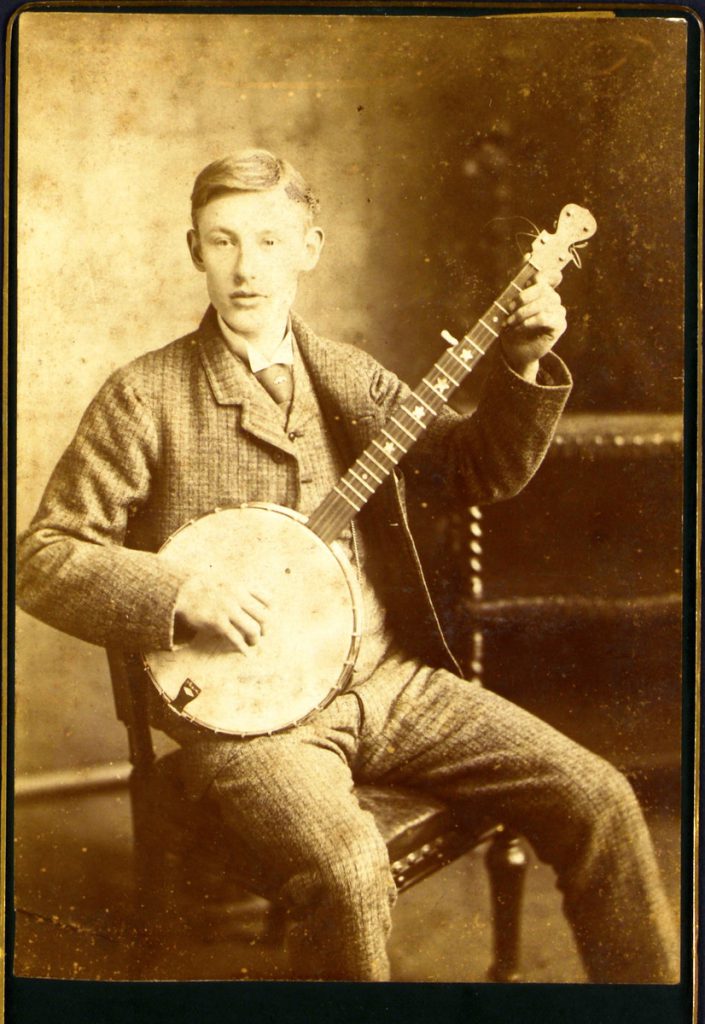
The banjo is a common feature of many Dolly Parton songs including an old classic ‘Applejack’, which tells the story of an old friend of Dolly’s who made applejack (the American version of scrumpy) and taught her to play the banjo whilst they drank. As well as an accomplished musician and writer, Dolly is known for her entrepreneurial thinking. Our town, Reading, had its own female entrepreneur, Mrs Dann of Dann-Lewis Studios, for whom we must thank for this excellent photo.
This banjo player is possibly a member of the Dann family and the photo was taken at the Dann-Lewis Studios. The photography studio opened in 1856 when Mrs Dann opened a shop at 35 Broad Street. This almost undoubtedly makes her Reading’s first female professional photographer, and something of a pioneer. Social conventions dictated that Mrs Dann’s husband Francis, a Great Western Railway worker, should give his name to the business. The studio was therefore registered as belonging to him, and his name appeared both over the door and in the local business directory. Although portraiture provided much of the early business, engagements also included local scenes and landmarks, pictures of outlying villages, important buildings, developing x-rays for the Hospital and regular visits to the Reading Police Station to photograph new prisoners.
On Mrs Dann’s retirement, the business was taken over by her granddaughter, who had grown up in the family business. Her marriage to Mr Henry Lewis (noted for his ‘Magic Lantern Shows’) led to a combination of their names: the business became Dann-Lewis and is listed as such in the 1903 local directory. By that time, the business had moved from Broad Street to London Street. When Henry Lewis died, his son, Walter, ran the business, by then at 27 Argyle Street, until its closure some time after the Second World War.
Love is Like a Butterfly
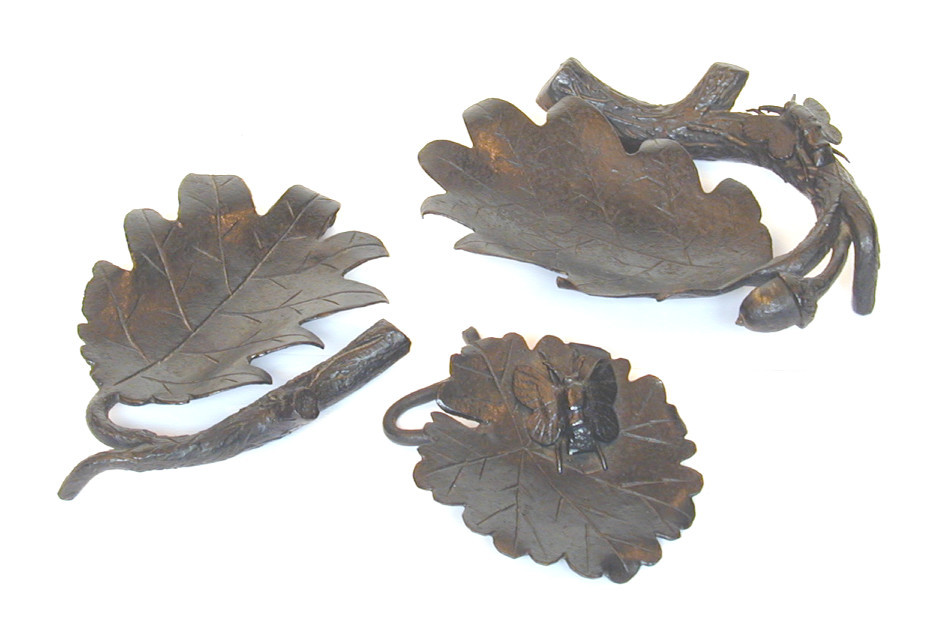
‘Love is like a butterfly, a rare and gentle thing’. The wise words of Dolly ring especially true in the case of these incredible wrought iron ornaments, featuring a little butterfly sitting on a leaf. These ornaments are totally unique, made by Arthur Holloway of Bradfield. According to his daughter-in-law Eliza Holloway, Arthur, born in 1883, was a blacksmith inspired by nature. As well as the occasional shoeing of a horse, he would go for walks and pick flowers, leaves, and take inspiration from nature to create his iron ornaments. All his works were made from one piece of iron, so nothing was soldered on or brazed, which must have been extremely tricky work when creating delicate pieces like leaves or the wings of a butterfly.
Speaking to the Evening Mail in 1970, Eliza recollects: ‘Once when we went on a walk, he picked out a flower he wanted to copy and made it when he got back. He often used to incorporate the design into something useful like a matchbox holder, candleholders, toasting forks, or mirrors. The chrysanthemums round my mirror are made of old nails out of an old horseshoe, although you would never believe it’.
Arthur was still shoeing the odd horse at the ripe old age of 70!
Why’d You Come in Here Lookin’ Like That?

Any country gal or guy knows the importance of denim, whether you wear your cowboy boots and ‘painted-on’ jeans, some fetching dungarees or even a denim dress if you are feeling particularly country-western.
This small Wiltshire smock was bought by the donor’s husband at the Post Office in Woodborough, Wiltshire, for 2 shillings and 6 pence. Estimated to have been made between 1882 and 1885, it is made of blue linen smocked with white and brown thread. It is embroidered with feather stitch on the front, back, collar and the top and bottom of the sleeves.
Smocks were the clothing of choice for agricultural workers for many years. They provided cover from sun and wind, allowed movement whilst maintaining modesty and was normally made from hardy fabrics that could withstand damage whilst being breathable. What a wonder! It was common for a labourer to have at least two smocks. One for everyday work and another for ‘Sunday Best’, which would be made of a finer material with more decorations than his usual work clothing.
The stitching on smocks would be different, and until recently it was believed the design alluded to the occupation of the wearer, so there would be wheel shapes for wheel-wrights, or crook shapes for shepherds, but this has recently been disputed. Although if it were true, it would make answering Dolly’s question a lot easier.
Joshua
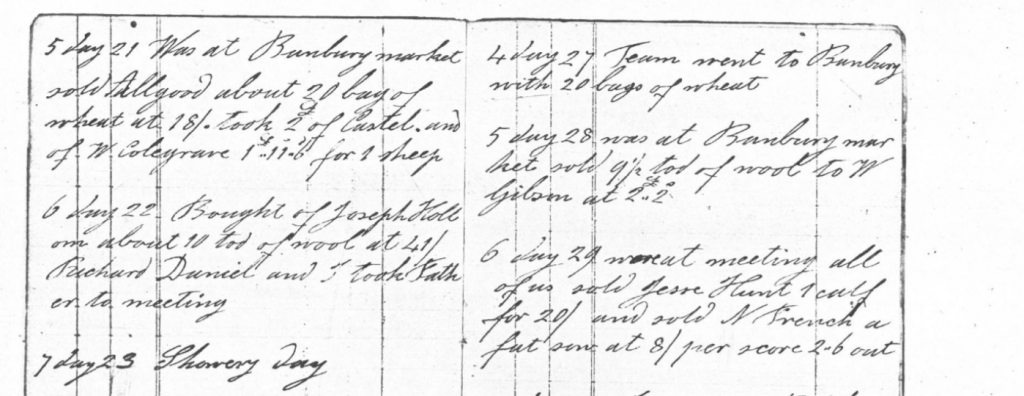
In 1971 Dolly sang a song all about a man named Joshua, a local celebrity in his own right, who everyone thought was a bit of a meany. Dolly heads off to meet him and would you believe it, they fall in love! Well, 50 years later, here’s my Joshua, although I’ll be honest I don’t think I’m going to fall in love with him, but who knows?
Joshua Lamb was a successful poultry farmer in Sibford, Banbury and he kept a diary and meticulous records which are now in the MERL archive. It was common practice for farmer’s to maintain a diary to keep track of work, sales and other interesting events that happened throughout the year. Joshua Lamb’s diary of 1836 gives us an insight to his farming life, as well as the goings on in the town of Sibford and an insight to the man himself.
Joshua seemed to be quite an unlucky traveller. On one occasion he was travelling back from Charlbury and for some reason he found himself quite uneasy at the idea of his wife not knowing he had decided to take a different route. It seems quite a simple fix but who knows what Joshua was thinking that day. Later in the month he took his horse and cart up to Banbury and apparently the horse had it’s own plans for the day. Instead of stopping, the horse decided to walk up and down the high street a number of times before the horse calmed down.
Alongside poultry farming and avoiding travel, Joshua was also big on weather. Everyday of his diary has a reference to the weather, such as ‘blustery’, ‘thundery’, ‘rainy’, ‘dreary’ and occasionally ‘fine’. Apparenly he was something of an expert on the weather, as he was quoted in the Banbury Advertiser (1896) as an official recorder of rainfall in the area! Go Joshua!
Thanks for joining us on our latest rural research outing! For more, keep checking The MERL blog.
Endnotes
i C. B. McCully (2000). The Language of Fly-Fishing. Taylor & Francis. p. 41
ii Andrew N. Herd. ‘Fly fishing techniques in the fifteenth century’
iii Final CCC Coho Salmon ESU Recovery Plan (Volume I of III). (2012, September). CCC. Retrieved from http://www.westcoast.fisheries.noaa.gov/publications/recovery_planning/salmon_steelhead/domains/north_central_california_coast/central_california_coast_coho/history_i.pd
iv https://www.bbc.co.uk/news/uk-england-36389585
v C. Jewell to Mr Hogben, Accession file 64/37-55, 13/03/1964

One thought on “Working (the land) 9 to 5”